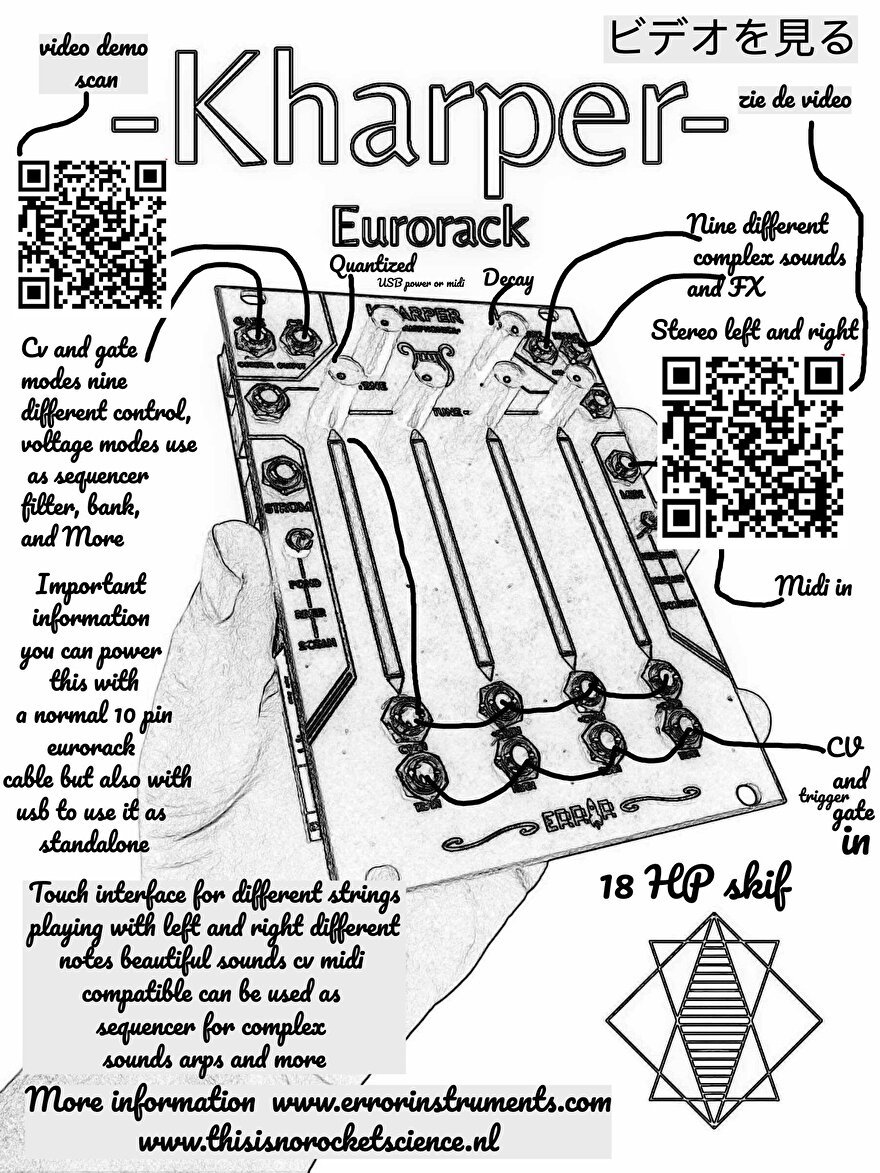soon 30 sep
kHarper eurorack
Overview
kHarper Electronic Harp with 4 strings
We built a physical version of the Karplus-Strong physical model for strings. There is a whole group of Karplus-Strong algos and we are using a bunch of them. We built 3*3 sound engines that are each producing four voices.
kHarper is easily epic and cinematic. Can do big bwaaps as well as slow and emotional chords. Unlike a banana.
4 strings
Every string is a voice. The strings are built out of two touch
strips with an LED bar in the middle, showing you
what kHarper is doing. Each string has a
knob on top to set the tone and a CV -in below. You can also patch
in a gate to pluck the string.
kHarper has a very wide range of sounds. You can go from wild distorted guitars to meditative soothing plinkies. Just like any other stringed instrument there are 10.000 ways to play.
Being able to touch these Karplus-Strong models adds the natural chaos of a physical manifestation. Plucking amazing.
kHarper
- OUTPUTS
- Control output Gate and CV
- Left/Right audio output
- INPUTS
- MIDI in
- STRUM is a gate in that will strum all four strings
- Pond/River/Ocean choice of sound engine
- Herring/Koikarp/Dolphin choice of sound engine
- Tone and Decay of the selected sound engine you can tweak with a knob or CV.
- All strings have a knob and CV in for tone and a trigger gate input to pluck the string see demo
- kHarper A new experimental sound platform — named after the Karp-Strong algorithm, and a harp. The kHarper is an experimental music device designed for musicians and sound artists who want to explore sonic textures beyond traditional synthesis. It’s available as a standalone unit or in Eurorack format. ⸻ What is it? The name kHarper comes from a blend of the Karp-Strong algorithm (used for plucked-string synthesis) and the idea of a harp, a deeply expressive and resonant instrument. This duality is at the core of the kHarper — a machine that’s both digital and organic, experimental yet immediate. ⸻ The Sounds The standard firmware includes nine sound models, grouped into three types — all inspired by aquatic lifeforms (each with its own character): 1. Herring – cinematic textures • These are your lush, deep sounds — evocative and atmospheric. 2. KoiKarp – percussive and rhythmic • Short, glitchy hits perfect for triggering patterns and textures. 3. Dolphin – experimental, glitch-heavy algorithms • Overdriven, clipped, noisy, and full of surprises — chaotic in a good way. Each group contains three variations, giving you 9 presets in total. ⸻ The Platform kHarper is not fixed. It’s a platform, not just a product. That’s why there’s a USB port on the back — for uploading new sounds, algorithms, or even full alternative firmwares. In the future, there could be: • Traditional oct tracking • Different quantization schemes • Ambient or generative patches Or more experimental warm or noisy • New forms of sound design — all possible through open-source updates ⸻ Control • CV and Gate inputs make it Eurorack-friendly. • Sequencing and modulation options are also open source. • There’s talk of a fader bank and other controller expansions in the works. ⸻ Important to Know kHarper isn’t trying to be the next “best synthesizer.” It’s not for pop music, and probably not for traditional synthesis either. It’s for those who love texture, surprise, distortion, and sonic exploration. It’s instant music. It’s instant love — if you’re into that kind of sound s
- Important Note: This instrument does not track 1V/octave using the standard firmware. If you intend to use a keyboard for melodic control, it’s recommended to use the MIDI input instead. This is a hands-on sound design instrument, designed for manual control and creative exploration. It is also compatible with CV, trigger, and gate signals, allowing for integration into a modular setup.







